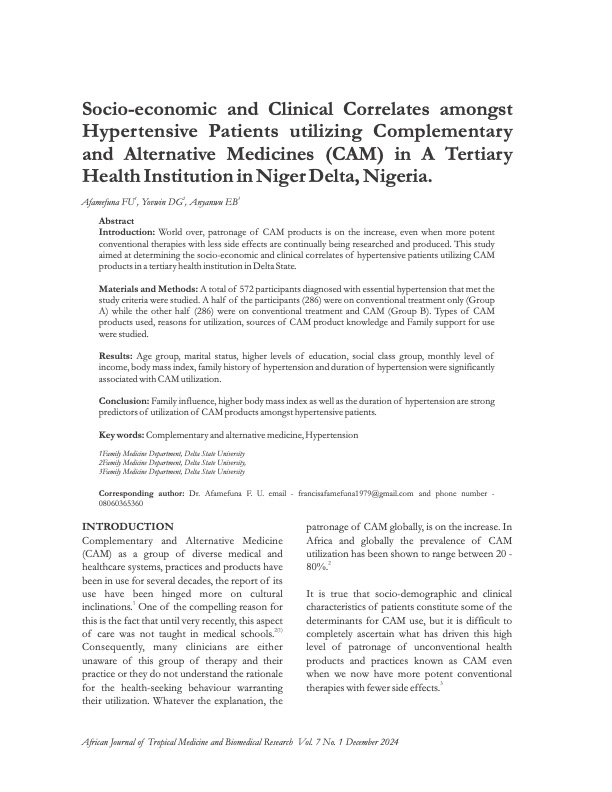Socio-economic and Clinical Correlates amongst Hypertensive Patients utilizing Complementary and Alternative Medicines (CAM) in A Tertiary Health Institution in Niger Delta, Nigeria.
DOI:
https://doi.org/10.4314/Keywords:
Complementary and alternative medicine, HypertensionAbstract
Introduction: World over, patronage of CAM products is on the increase, even when more potent conventional therapies with less side effects are continually being researched and produced. This study aimed at determining the socio-economic and clinical correlates of hypertensive patients utilizing CAM products in a tertiary health institution in Delta State.
Materials and Methods: A total of 572 participants diagnosed with essential hypertension that met the study criteria were studied. A half of the participants (286) were on conventional treatment only (Group A) while the other half (286) were on conventional treatment and CAM (Group B). Types of CAM products used, reasons for utilization, sources of CAM product knowledge and Family support for use were studied.
Results: Age group, marital status, higher levels of education, social class group, monthly level of income, body mass index, family history of hypertension and duration of hypertension were significantly associated with CAM utilization.
Conclusion: Family influence, higher body mass index as well as the duration of hypertension are strong predictors of utilization of CAM products amongst hypertensive patients.
References
Onyiapat JL, Okoronkwo IL, Ogbonnaya NP. Complementary and alternative medicine use among adults in Enugu, Nigeria. BMC Complement Altern Med. 2011;11:19.
Ortiz BI, Shields KM, Clauson KA, Clay PG. Complementary and alternative medicine use among Hispanics in the United States. Ann Pharmacother. 2007; 41(6):994-1004.
Idung AU, Okokon IB, Udoh SB, Inem VA. Clinical and socio demographic profiles of complementary and alternative medicine users among outpatient clinic attendees in Uyo, South-South, Nigeria. Fam Med Sci Res. 2014; 3:117.
Osamor PE, Owumi BE. Complementary and alternative medicine in the management of hypertension in an urban Nigerian community. BMC Complement Altern Med. 2010; 10:36.
Ching S, Ramachandran V, Zainul Z, Fuziah P. Frequency of complementary and alternative medicine usage among Malaysian hypertensive subjects. Life Sci J. 2013; 10(4):2526-2531.
Irene AK, Frances O, Samuel D. Patterns and determinants of the use of complementary and alternative medicine: A cross-sectional study of hypertensive patients in Ghana. BMC Complement Altern Med. 2014; 14:44.
Nuhawa F, Musinguzi G. Use of alternative medicine for hypertension in Buikwe and Mukono districts of Uganda: A cross sectional study. BMC Complement Altern Med. 2013; 13:301.
Amira OC, Okubadejo NU. Frequency of complementary and alternative medicine utilization in hypertensive patients attending an urban tertiary care centre in Nigeria. BMC Complement Altern Med. 2007; 7: 30.
National Readership Survey. Social Grade. 2015. www.nrs.co.uk/nrs-print/lifestyle-andclassification-data/social-grade (accessed 16 March 2015).
Paul AJ, Suzanne O, Barry LC, William CC, Cheryl D, Joel H, et al. 2014 evidence-based guideline for the management of high blood pressure in adults: Report from the panel members appointed to the eighth joint national committee (JNC 8). JAMA. 2014; 311(5):507-520.
del Mundo WFB, Shepherd WC, Marose TD. Use of alternative medicine by patients in a rural family practice clinic. Fam Med. 2002; 34(3):206-212.
Huanhuan Hu, Gang Li, Jiali Duan, Takashi Arao. Prevalence, purposes, and perceived effectiveness of complementary and alternative medicine use in a hypertension population: A questionnaire survey. ISRN Public Health. 2013; ID 137472.
Mohammed SA, Rana MJ, Rania MJ, Nihaya MYS. Complementary and alternative medicine use among hypertensive patients in Palestine. Complementary Therapies in Clinical Practice. 2013; 19(4):256-263.
Adisa R, Fakeye TO. Assessment of knowledge of Community Pharmacists regarding common phytopharmaceuticals sold in South Western Nigeria. Tropical JPharm Res. 2006; 5:611-625.
National Population Commission. Delta S t a t e p o p u l a t i o n . 2 0 1 0 . www.population.gov.ng/index.php/deltastate (accessed 15 July 2014).
Nahida T, Feroz A. Role of natural herbs in the treatment of hypertension. Pharmacogn Rev. 2011; 5(9): 30-40.
Reinhart KM, Coleman CI, Teevan C, Vachhani P, White CM. Effects of garlic on blood pressure in patients with and without systolic hypertension: A meta-analysis. Ann Pharmacother. 2008; 42:1766-1771.
Oke DA, Bamidele EO. Misconceptions of hypertension. Journal of the National Medical Association. 2004; 96:1221-1224.
Chimezie GO Nnamdi EO, Enajite IO, Fatai MA. Patient-related barriers to hypertension control in a Nigerian population. Int J Gen Med. 2014; 7:345–353.
Sood A, Sood R, Brinker FJ, Mann R, Loehrer LL. Potential for interactions between dietary supplements and prescription medications. Am J Med. 2008; 121:207-211.

Downloads
Published
Issue
Section
License
Copyright (c) 2025 African Journal of Tropical Medicine and Biomedical Research

This work is licensed under a Creative Commons Attribution-NonCommercial-ShareAlike 4.0 International License.
Key Terms:
- Attribution: You must give appropriate credit to the original creator.
- NonCommercial: You may not use the material for commercial purposes.
- No Derivatives: You may not remix, transform, or build upon the material.
- Sharing: You may distribute the original work, but only for non-commercial purposes and without modifications.
For full details, please review the Complete License Terms.



